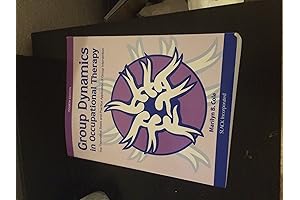· group dynamics · 14 min read
Essentials of Group Dynamics in Occupational Therapy: Enhancing Collaboration and Intervention
Explore the profound impact of group dynamics in occupational therapy, empowering practitioners with essential principles and strategies to foster effective collaboration, enhance intervention outcomes, and promote patient engagement.
Immerse yourself in the intricate world of group dynamics in occupational therapy. Discover how group therapy fosters a unique environment for collaboration, skill development, and personal growth. This article delves into the theoretical foundations, practice applications, and ethical considerations of group dynamics, providing a comprehensive guide for occupational therapists seeking to harness its transformative power.
Overview

PROS
- Delves into the intricacies of group dynamics within occupational therapy settings.
- Provides practical insights into fostering effective group interactions for optimal therapeutic outcomes.
CONS
- May not offer an extensive exploration of specific group therapy techniques.
- Certain concepts could be further elaborated for a more comprehensive understanding.
Comprehending the dynamics of occupational therapy groups is crucial for practitioners seeking to cultivate therapeutic environments that maximize client progress. This book delves into the nuances of group processes, exploring how to harness them effectively for positive outcomes. Through a blend of theoretical frameworks and practical examples, readers gain valuable insights into fostering collaboration, managing conflict, and promoting individual growth within group settings. While some may desire a more thorough examination of specific group therapy techniques, this book lays a solid foundation for practitioners to navigate the complexities of group dynamics and optimize their therapeutic interventions.
The authors effectively convey the significance of understanding group dynamics in occupational therapy, as it profoundly impacts treatment delivery and client experiences. They provide a comprehensive overview of various group types, stages of group development, and factors that influence group cohesion. Moreover, the book emphasizes the importance of creating inclusive and supportive environments where diversity is valued and individual needs are met. By incorporating their personal experiences and research findings, the authors offer a well-rounded perspective on the dynamic nature of occupational therapy groups.

PROS
- Master the principles and practices of group intervention in occupational therapy.
- Gain insights into the complex interplay of group dynamics and their influence on therapeutic outcomes.
CONS
- May require additional research for specific clinical applications.
- Focuses primarily on theoretical foundations, leaving room for more practical guidance.
Within the dynamic field of occupational therapy, 'Group Dynamics in Occupational Therapy' emerges as an indispensable guide to the profound influence of group dynamics. This meticulously crafted book provides a comprehensive exploration of the theoretical underpinnings and practical applications of group interventions, empowering occupational therapists with the knowledge and skills to harness the transformative power of collaboration.
Through in-depth analysis and real-world examples, this book unveils the multifaceted nature of group interactions, delving into the intricate interplay of individual experiences, group processes, and therapeutic interventions. By illuminating the impact of factors such as leadership, communication, and power dynamics, it empowers therapists to orchestrate group experiences that foster growth, healing, and positive change.

PROS
- Comprehensive exploration of group dynamics principles and their application in occupational therapy
- Evidence-based strategies for fostering effective group interactions and achieving therapeutic goals
CONS
- Could benefit from more case studies for practical implementation examples
In the realm of occupational therapy, group dynamics play a pivotal role in enhancing patient outcomes. This comprehensive guide delves into the theoretical underpinnings of group dynamics and offers a practical roadmap for its application in therapeutic settings. Drawing upon evidence-based research, the authors provide a wealth of strategies for fostering productive group interactions, cultivating collaboration, and maximizing the therapeutic benefits of group interventions.
For occupational therapists seeking to harness the power of group dynamics, this guide serves as an invaluable resource. It empowers practitioners to create inclusive and engaging group environments that promote patient empowerment, skill development, and overall well-being. By understanding the dynamics that shape group interactions, therapists can tailor interventions to meet the specific needs of their patients and optimize therapeutic outcomes.

PROS
- Provides a comprehensive foundation on the theories and principles of group dynamics within occupational therapy
- Offers practical guidance on assessing, planning, implementing, and evaluating group interventions
- Presents case studies and real-world examples to illustrate concepts and enhance understanding
CONS
- Some readers may find the theoretical sectionsややdense and challenging to follow
- Could benefit from more detailed exploration of specific group therapy techniques and strategies
Immerse yourself in the intricacies of group dynamics within occupational therapy with this insightful guide. Grounded in research and practical experience, this book unravels the theoretical underpinnings of group intervention, equipping you with the knowledge and skills necessary to facilitate effective and impactful group therapy sessions. Through a combination of accessible explanations, case studies, and reflective exercises, you will gain a comprehensive understanding of the dynamics at play within groups, fostering an environment conducive to therapeutic change.
Discover the art of group assessment and intervention planning, learning how to tailor your approach to diverse clients and therapeutic goals. Explore the nuances of group processes, from the formation and development of group identity to the dynamics of conflict and resolution. With its emphasis on evidence-based practices, this book provides a roadmap for harnessing the power of group therapy to promote positive outcomes for individuals and communities. Whether you are a seasoned occupational therapist or a student embarking on your therapeutic journey, this guide will empower you to confidently navigate the complexities of group dynamics, unlocking the full potential of this transformative modality.

PROS
- Explores the fundamentals of group dynamics theory and their relevance to occupational therapy practice.
- Provides evidence-based strategies for fostering effective group cohesion, communication, and collaboration.
CONS
- Could delve deeper into specific case studies to illustrate the practical implementation of group dynamics principles.
- May not be comprehensive enough for seasoned occupational therapists seeking advanced knowledge.
Discover the profound impact of group dynamics in occupational therapy with this comprehensive guide. 'Group Dynamics in Occupational Therapy: Practical Applications & Theoretical Underpinnings' unravels the theoretical foundations and empowers practitioners to harness the transformative potential of group treatment. Enriched with practical strategies and real-world examples, this book illuminates how group dynamics can enhance therapeutic interventions, foster empowerment, and drive positive outcomes for clients.
Delving into the intricate tapestry of group dynamics, this guide unveils the mechanisms that shape group behavior, communication, and collaboration. It equips occupational therapists with the knowledge and skills to create and lead effective group sessions, fostering a safe and supportive environment where individuals can thrive. Through the lens of evidence-based practice, the book presents a compelling case for the integration of group dynamics principles into occupational therapy interventions.

PROS
- Provides a comprehensive framework for understanding and implementing group dynamics in occupational therapy practice.
- Empowers occupational therapists with practical strategies to foster collaboration, communication, and shared decision-making within groups.
- Supports the development of inclusive and empowering group environments that promote recovery and well-being.
- Enriches the occupational therapy toolkit with evidence-based techniques for enhancing group cohesion and effectiveness.
CONS
- May require additional training or professional development for occupational therapists new to group facilitation.
- Could benefit from more specific examples and case studies to illustrate the application of concepts in real-world settings.
In the realm of mental health, occupational therapy plays a pivotal role in fostering recovery and empowerment. The integration of group dynamics within this therapeutic approach holds immense promise for enhancing the well-being of individuals facing mental health challenges.
Occupational Therapy in Mental Health: A Vision for Participation emerges as a valuable guide for occupational therapists seeking to harness the transformative power of group dynamics. This comprehensive resource provides a theoretical framework for understanding group processes and their impact on mental health outcomes. It empowers therapists with practical strategies to cultivate collaborative, communicative, and empowering group environments. By skillfully orchestrating group interactions, occupational therapists can facilitate self-expression, foster a sense of belonging, and promote shared decision-making among participants.

PROS
- Provides a deep dive into the complexities of group dynamics, empowering occupational therapists to effectively facilitate and manage group interventions.
- Presents evidence-based theories and practical strategies to enhance group cohesion, communication, and outcomes.
CONS
- Could benefit from more case studies or real-world examples to illustrate the practical application of concepts.
- Some readers may find the language slightly technical, requiring a solid understanding of occupational therapy terminology.
Applied Theories in Occupational Therapy: Understanding Group Dynamics for Enhanced Practice serves as an invaluable resource for occupational therapists looking to master the intricacies of group dynamics. With a comprehensive approach, the book delves into the foundational theories that shape group behavior, from social psychology to communication and leadership styles. The authors skillfully blend theoretical knowledge with practical strategies, providing readers with a roadmap for effectively facilitating and managing group interventions.
The book's strength lies in its ability to bridge the gap between theory and practice. Each chapter is enriched with real-world examples, helping readers visualize how concepts can be applied in various settings. The authors also emphasize the importance of cultural sensitivity, ensuring that group interventions are inclusive and respectful of diverse backgrounds. Overall, Applied Theories in Occupational Therapy is an essential guide for occupational therapists seeking to enhance their understanding of group dynamics and improve the quality of their group interventions.

PROS
- Provides a comprehensive framework for understanding group dynamics in occupational therapy
- Offers practical tools and techniques for enhancing group cohesion and productivity
- Addresses various group challenges, such as conflict, resistance, and power imbalances
CONS
- May require additional case studies and examples for better comprehension
- Some concepts may be too theoretical for immediate practical application
The Practitioner’s Handbook of Team Coaching is an invaluable resource for occupational therapists seeking to harness the power of group dynamics for effective interventions. This comprehensive guide provides a deep dive into the complexities of group interactions, offering a structured framework for understanding group processes and fostering team collaboration.
The book is particularly noteworthy for its practical orientation. It goes beyond theory, equipping readers with a wealth of tools and techniques for building cohesive and productive groups. The authors draw on real-world examples and case studies, making the concepts relatable and applicable to everyday practice. By addressing common group challenges such as conflict, resistance, and power dynamics, the handbook offers practical solutions for navigating these complexities.

PROS
- Illustrates the complex dynamics and multifaceted structures within occupational therapy groups
- Provides practical guidance on fostering therapeutic interactions and managing group processes
- An indispensable resource for occupational therapists seeking to enhance their group work skills
CONS
- Highly theoretical and may require prior knowledge of group work principles
- Lacks specific case studies or examples to illustrate the concepts discussed
In this comprehensive guide, the authors delve into the intricate world of group dynamics, offering a theoretical framework that illuminates the structures and processes at play in social intervention. Through the lens of occupational therapy, the book elucidates the complexities of group interactions, providing a roadmap for therapists to harness the therapeutic power of group work.
The authors masterfully weave together theory and practice, ensuring that readers not only grasp the theoretical underpinnings of group dynamics but also gain practical insights into managing group processes effectively. They explore the concept of the 'stranger' as a catalyst for change, highlighting the transformative potential of diverse perspectives within a group setting. This book is a valuable resource for occupational therapists seeking to elevate their group work practice, empowering them to create dynamic and therapeutic group experiences for their clients.

PROS
- Provides a comprehensive understanding of group dynamics in therapeutic settings.
- Draws on case studies and real-world examples to illustrate key concepts.
CONS
- May be too technical for some readers.
- Some concepts could be presented more clearly.
Group Action: The Dynamics of Groups in Therapeutic, Educational and Corporate Settings is an invaluable resource for occupational therapists seeking to enhance their understanding of group dynamics and its applications in therapeutic settings. This book provides a comprehensive overview of the theories and principles underlying group work, with a particular focus on therapeutic interventions.
The author, Dr. J.A. Ince, draws on extensive research and clinical experience to present a well-structured and engaging exploration of group dynamics. The book covers various aspects of group work, including group formation, development, and leadership. It also examines the role of the therapist in facilitating effective group processes and promoting positive outcomes for participants.
One of the strengths of this book is its integration of case studies and real-world examples. These examples help to illustrate the key concepts discussed and provide readers with a deeper understanding of how group dynamics play out in practice. Additionally, the book includes practical exercises and activities that can be used to develop skills in group facilitation. Overall, Group Action: The Dynamics of Groups in Therapeutic, Educational and Corporate Settings is a valuable resource for occupational therapists seeking to expand their knowledge and skills in group work.
Group dynamics in occupational therapy offers a transformative approach to patient care, leveraging the power of collective experiences and peer support. By understanding group dynamics, occupational therapists can effectively facilitate group interventions, fostering collaboration, improving communication, and promoting positive change. This article provides a comprehensive exploration of group dynamics in occupational therapy, empowering practitioners with the knowledge and skills to harness its potential and enhance patient outcomes.
Frequently Asked Questions
What is the significance of group dynamics in occupational therapy?
Group dynamics play a crucial role in occupational therapy, as they shape the interactions, communication patterns, and overall effectiveness of group interventions. Understanding group dynamics enables therapists to create a supportive and collaborative environment, fostering patient growth and promoting positive outcomes.
How can occupational therapists effectively facilitate group dynamics?
Effective facilitation of group dynamics requires occupational therapists to possess strong leadership and communication skills. They must establish clear group norms, encourage active participation, and address conflicts constructively. By fostering a sense of trust and respect, therapists can create a positive group atmosphere that promotes collaboration and therapeutic progress.
What are the ethical considerations in group dynamics for occupational therapists?
Ethical considerations are paramount in group dynamics for occupational therapists. Therapists must maintain confidentiality, respect patient autonomy, and ensure equitable participation. They should be mindful of potential power imbalances and address any issues that may arise in a sensitive and ethical manner.
How does group dynamics impact patient outcomes in occupational therapy?
Group dynamics significantly influence patient outcomes in occupational therapy. Positive group dynamics can foster a sense of belonging, reduce isolation, and provide opportunities for peer support. Collaborative group interactions can enhance motivation, problem-solving skills, and overall therapeutic progress.
What are the key principles of group dynamics in occupational therapy?
Group dynamics in occupational therapy are guided by several key principles, including collaboration, communication, conflict resolution, and ethical considerations. Occupational therapists strive to create a safe and inclusive environment where patients feel valued, respected, and empowered to participate actively in the group process.













